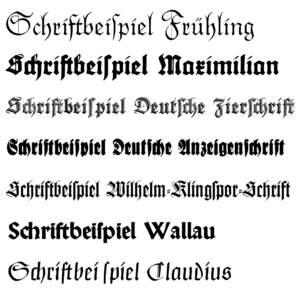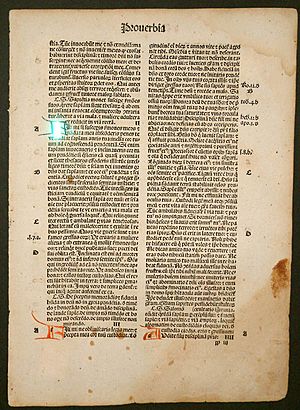Blackletter facts for kids
Blackletter, also known as Gothic script, is an old style of writing. People used Blackletter for writing and printing in Western Europe from around 1150 to the 1600s. In Germany, it was even used for printing until the 1900s.
The shapes of Blackletter letters in printed books came from how people wrote by hand. This means that both the Gothic script from northern Europe and the Latin script from Italy were copied into early typography (the art of arranging type).
What's in a Name? The Gothic Script
Some people mistakenly call blackletter "Old English". This is not correct. Old English is a language, not a writing style. It is also many centuries older than Blackletter.
Also, the name Gothic script has nothing to do with the Goths. The Goths were an ancient group of people who lived from the 3rd to 6th century. They wrote using runes. Blackletter should also not be confused with the ancient Gothic alphabet. It's also different from sans-serif typefaces, which are sometimes called Gothic too.
The name Gothic was first used for this script in 15th-century Italy. This was during the Renaissance period. Scholars at that time thought it looked like a barbaric script. For them, Gothic was a word meaning barbaric.
They called not only blackletter forms "Gothic script," but also any other script they thought looked "barbaric." In contrast, scholars preferred the Carolingian minuscule. This was a very easy-to-read script. They called it littera antiqua, which means "the ancient letter." They believed it was the script used by the Romans. However, it was actually created during the time of Charlemagne.
How Blackletter Began
Carolingian minuscule was the direct ancestor of blackletter. Blackletter developed from Carolingian writing. This happened because Europe in the 1100s needed many new books. More and more people were learning to read.
New universities were being started. Each university needed books for subjects like business, law, grammar, and history. Before this, most books were religious.
These new books needed to be made quickly to meet the high demand. Carolingian script was easy to read, but it took a long time to write. It was also large and wide. This meant it used a lot of space on a manuscript. Writing materials were very expensive back then.
By the 11th century, different forms of Carolingian were already in use. By the mid-12th century, a new, clear style appeared. This style could be written much faster. It was used in north-eastern France and the Low Countries to keep up with the demand for new books.
Images for kids
-
Page from a 14th-century psalter (Vulgate Ps 93:16–21), with blackletter "sine pedibus" text. Luttrell Psalter, British Library.
-
Blackletter in a Latin Bible of 1407 AD, on display in Malmesbury Abbey, Wiltshire, England
-
Handbill of 1715, with the main text in blackletter type, publishing a royal proclamation for the apprehension of the Jacobite leader Sir William Wyndham
-
Schwabacher lettering. The text reads: "Beispiel Alte Schwabacher: Victor jagt zwölf Boxkämpfer quer über den Sylter Deich." Roughly translated to English, it reads "Example of Old Schwabacher: Victor chases twelve boxers across the Sylt dike."
-
Fraktur lettering. The text reads: "Walbaum-Fraktur: Victor jagt zwölf Boxkämpfer quer über den Sylter Deich." Roughly translated to English, it reads "Walbaum Fraktur: Victor chases twelve boxers across the Sylt dyke."
See also
 In Spanish: Escritura gótica para niños
In Spanish: Escritura gótica para niños








